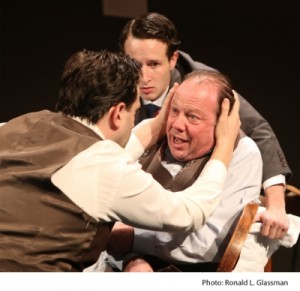In today’s Wall Street Journal “Sightings” column I discuss adaptations of well-known works of art that are better than (or as good as) the originals. Here’s an excerpt.
* * *
If you’re the kind of adventure-loving theatergoer who can’t think of a good reason to see “The Gin Game” again, you might want to check out New Yiddish Rep’s off-Broadway production of “Death of a Salesman,” which runs through Nov. 22 at the Castillo Theatre. Why? Because it’s being done in Yiddish, the amalgam of Hebrew and German that was heard in the ghettoes of Central Europe prior to the Holocaust and continues to be spoken by Hasidic and Orthodox Jews throughout the world.
 I have yet to see this staging, but it’s clear from reading the script, which was translated in 1951 by Joseph Buloff, that “Death of a Salesman” has profited immensely from the change in languages. Even though Willy and Linda Loman are as self-evidently Jewish as bagels and lox, Miller deliberately deracinated their characters on the page to make their plight seem more universal to Gentile audiences. That’s why their lines sound more authentic in Yiddish (which you don’t have to speak to follow the production—it uses English-language supertitles). Instead of the inflated pseudo-poetry of Miller’s original text, you get the guttural lilt of a homely tongue that comes naturally to such beleaguered souls. In Yiddish, Linda’s notoriously clumsy “Attention, attention must be finally paid to such a person” has the stark ring of a death sentence: “Achtung gebn af im.”
I have yet to see this staging, but it’s clear from reading the script, which was translated in 1951 by Joseph Buloff, that “Death of a Salesman” has profited immensely from the change in languages. Even though Willy and Linda Loman are as self-evidently Jewish as bagels and lox, Miller deliberately deracinated their characters on the page to make their plight seem more universal to Gentile audiences. That’s why their lines sound more authentic in Yiddish (which you don’t have to speak to follow the production—it uses English-language supertitles). Instead of the inflated pseudo-poetry of Miller’s original text, you get the guttural lilt of a homely tongue that comes naturally to such beleaguered souls. In Yiddish, Linda’s notoriously clumsy “Attention, attention must be finally paid to such a person” has the stark ring of a death sentence: “Achtung gebn af im.”
As I worked my way through the transliterated script of “Toyt fun a Seylsman,” I caught myself thinking of Deaf West Theater’s revival of “Spring Awakening,” which is being performed on Broadway in a mixture of American Sign Language (used by the deaf actors) and spoken and sung English (used by the hearing actors). Even though I don’t like the musical, I was thrilled by the staging. Just as the use of Yiddish in “Death of a Salesman” makes manifest what was only latent in Miller’s English-language version, so does the use of ASL in “Spring Awakening” add a rich new layer of visual symbolism to a musical with an expressively inadequate score. In other words, translating these two shows has made them better.
Such retrospective improvements are not unknown in the world of art. Indeed, David Ives has gone so far as to coin the word “translaptation” to describe his own translations of such obscure 17th- and 18th-century French comedies as Jean-François Regnard’s “The Heir Apparent” and Pierre Corneille’s “The Liar,” in which he recasts the text in crisply contemporary iambic pentameter and jiggers with the plot to spectacular comic effect. But none of these shows, not even “Death of a Salesman,” is a great work of art by any stretch of the imagination, and that leads me to wonder: Might it also be possible to improve on a masterwork?
Perhaps not, but when a major artist revisits a masterwork, strange and wonderful things can happen….
* * *
Read the whole thing here.
A scene from New Yiddish Rep’s 2013 production of Waiting for Godot, translated into Yiddish by Shane Baker and subtitled in English:
